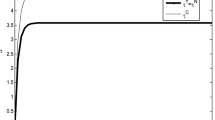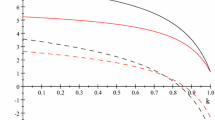Abstract
In much of today’s competitive marketplace, consumers have the opportunity to choose where they spend their money based on their examination of a company’s corporate social responsibility. A company’s social reputation and its promotional efforts may influence consumer choice. Sustainable development is highly regarded by governments, experts, decision-makers and managers in organizations and two-level supply chains. This supply chain includes a manufacturer (acting as leader) and a retailer (acting as follower), both of whom face demand uncertainty. In this article, the cost of advertising is considered in two ways for the manufacturer and the retailer. In the first model, the retailer determines the optimal retail price and order quantity, and the manufacturer determines the optimal wholesale price and the promotional efforts value so that their profits are maximized. In the second model, the retailer determines the optimal retail price, order quantity, and promotional efforts value, and the manufacturer determines the optimal wholesale price. We will also study the impact of promotional cost sharing on the coordination of the supply chain and the issue will be further explained with numerical examples. Therefore, in this research, the simultaneous effect of increased advertising and value consumer surplus is studied We examine cases when the retailer is a provider of promotional cost and profit, when consumer surplus is directed toward the retailer, and when both retailer and manufacturer achieve higher profits than when the manufacturer is responsible for promotional cost and profit.

























Similar content being viewed by others
References
Amrouche, N., & Yan, R. (2016). A manufacturer distribution issue: How to manage an online and a traditional retailer. Annals of Operations Research,244, 257–294.
Cárdenas-Barrón, L. E., & Sana, S. S. (2015). Multi-item EOQ inventory model in a two-layer supply chain while demand varies with promotional effort. Applied Mathematical Modelling,39(21), 6725–6737.
Chen, T. H. (2014). On the impact of cooperative advertising and pricing for a manufacturer-retailer supply chain. Journal of Industrial and Production Engineering,31(7), 417–424.
Chen, J., Liang, L., Yao, D.-Q., & Sun, S. (2017). Price and quality decisions in dual-channel supply chains. European Journal of Operational Research,259, 935–948.
Chintapalli, P., Disney, S. M., & Tang, C. (2017). Coordinating supply chains via advance-order discounts, minimum order quantities, and delegations. Production and Operations Management,26, 2175–2186.
Chopra, S. & Meindl, P. (2007). Supply chain management. Strategy, planning & operation. In Das summa summarum des management (pp. 265–275).
Cruz, J. M., & Wakolbinger, T. (2008). Multiperiod effects of corporate social responsibility on supply chain networks, transaction costs, emissions, and risk. International Journal of Production Economics,116(1), 61–74.
De, S. K., & Sana, S. S. (2015). An alternative fuzzy EOQ model with backlogging for selling price and promotional effort sensitive demand. International Journal of Applied and Computational Mathematics,1(1), 69–86.
García-Melón, M., Pérez-Gladish, B., Gómez-Navarro, T., & Mendez-Rodriguez, P. (2016). Assessing mutual funds’ corporate social responsibility: a multistakeholder-AHP based methodology. Annals of Operations Research,244, 475–503.
Garriga, E., & Melé, D. (2004). Corporate social responsibility theories: Mapping the territory. Journal of Business Ethics,53(1–2), 51–71.
Giri, B., Bardhan, S., & Maiti, T. (2013). Coordinating a two-echelon supply chain through different contracts under price and promotional effort-dependent demand. Journal of Systems Science and Systems Engineering,22(3), 295–318.
Giri, B., & Sarker, B. (2016). Coordinating a two-echelon supply chain under production disruption when retailers compete with price and service level. Operational Research,16(1), 71–88.
Goering, G. E. (2008). Socially concerned firms and the provision of durable goods. Economic Modelling,25, 575–583.
Gunasekaran, A., & Spalanzani, A. (2012). Sustainability of manufacturing and services: Investigations for research and applications. International Journal of Production Economics,140(1), 35–47.
Herbon, A., & Khmelnitsky, E. (2017). Optimal dynamic pricing and ordering of a perishable product under additive effects of price and time on demand. European Journal of Operational Research,260, 546–556.
Heydari, J., & Norouzinasab, Y. (2015). A two-level discount model for coordinating a decentralized supply chain considering stochastic price-sensitive demand. Journal of Industrial Engineering International,11(4), 531–542.
Hsueh, C. F. (2014). Improving corporate social responsibility in a supply chain through a new revenue sharing contract. International Journal of Production Economics,151, 214–222.
Jadidi, O., Taghipour, S., & Zolfaghari, S. (2016). A two-price policy for a newsvendor product supply chain with time and price sensitive demand. European Journal of Operational Research,253, 132–143.
Jaggi, C. K., Tiwari, S., & Goel, S. K. (2017). Credit financing in economic ordering policies for non-instantaneous deteriorating items with price dependent demand and two storage facilities. Annals of Operations Research,248, 253–280.
Jenkins, H., & Yakovleva, N. (2006). Corporate social responsibility in the mining industry: Exploring trends in social and environmental disclosure. Journal of Cleaner Production,14(3), 271–284.
Kannan, D. (2018). Role of multiple stakeholders and the critical success factor theory for the sustainable supplier selection process. International Journal of Production Economics, 195, 391–418.
Karray, S. (2011). Effectiveness of retail joint promotions under different channel structures. European Journal of Operational Research,210(3), 745–751.
Khouja, M., & Zhou, J. (2010). The effect of delayed incentives on supply chain profits and consumer surplus. Production and Operations Management,19(2), 172–197.
Krishnan, H., Kapuscinski, R., & Butz, D. A. (2004). Coordinating contracts for decentralized supply chains with retailer promotional effort. Management Science,50(1), 48–63.
Lamata, M. T., Liern, V., & Pérez-Gladish, B. (2018). Doing good by doing well: A MCDM framework for evaluating corporate social responsibility attractiveness. Annals of Operations Research, 267, 249–266.
Li, B., Hou, P. W., Chen, P., & Li, Q. H. (2016). Pricing strategy and coordination in a dual channel supply chain with a risk-averse retailer. International Journal of Production Economics,178, 154–168.
Li, X., Li, Y., & Cai, X. (2013). Double marginalization and coordination in the supply chain with uncertain supply. European Journal of Operational Research,226(2), 228–236.
Maihami, R., & Karimi, B. (2014). Optimizing the pricing and replenishment policy for non-instantaneous deteriorating items with stochastic demand and promotional efforts. Computers & Operations Research,51, 302–312.
Modak, N. M., Panda, S., & Sana, S. S. (2016). Pricing policy and coordination for a two-layer supply chain of duopolistic retailers and socially responsible manufacturer. International Journal of Logistics Research and Applications, 19, 487–508.
Modak, N. M., Panda, S., Sana, S. S., & Basu, M. (2014). Corporate social responsibility, coordination and profit distribution in a dual-channel supply chain. Pacific Science Review,16(4), 235–249.
Moir, L. (2001). What do we mean by corporate social responsibility? Corporate Governance: The International Journal of Business in Society,1(2), 16–22.
Montiel, I. (2008). Corporate social responsibility and corporate sustainability separate pasts, common futures. Organization and Environment,21(3), 245–269.
Nematollahi, M., Hosseini-Motlagh, S.-M., & Heydari, J. (2017). Coordination of social responsibility and order quantity in a two-echelon supply chain: A collaborative decision-making perspective. International Journal of Production Economics,184, 107–121.
Ni, D., & Li, K. W. (2012). A game-theoretic analysis of social responsibility conduct in two-echelon supply chains. International Journal of Production Economics,138(2), 303–313.
Pal, B., Sana, S. S., & Chaudhuri, K. (2015). Coordination contracts for competitive two-echelon supply chain with price and promotional effort sensitive non-linear demand. International Journal of Systems Science: Operations and Logistics,2(2), 113–124.
Palanivel, M., & Uthayakumar, R. (2017). A production-inventory model with promotional effort, variable production cost and probabilistic deterioration. International Journal of System Assurance Engineering and Management, 8, 290–300.
Pan, K., Lai, K. K., Liang, L., & Leung, S. C. (2009). Two-period pricing and ordering policy for the dominant retailer in a two-echelon supply chain with demand uncertainty. Omega,37(4), 919–929.
Panda, S. (2014). Coordination of a socially responsible supply chain using revenue sharing contract. Transportation Research Part E: Logistics and Transportation Review,67, 92–104.
Panda, S., Modak, N., Basu, M., & Goyal, S. (2015). Channel coordination and profit distribution in a social responsible three-layer supply chain. International Journal of Production Economics,168, 224–233.
Panda, S., Modak, N., & Pradhan, D. (2016). Corporate social responsibility, channel coordination and profit division in a two-echelon supply chain. International Journal of Management Science and Engineering Management,11(1), 22–33.
Pattnaik, M. (2012). Effect of deteriorating items and promotional effort factor in fuzzy instantaneous replenishment model. International Journal of Management Science and Engineering Management,7(4), 303–311.
Priyan, S., Palanivel, M., & Uthayakumar, R. (2015). Two-echelon production-inventory system with fuzzy production rate and promotional effort dependent demand. Journal of Management Analytics,2(1), 72–92.
Ramanathan, U., & Muyldermans, L. (2010). Identifying demand factors for promotional planning and forecasting: A case of a soft drink company in the UK. International Journal of Production Economics,128(2), 538–545.
Roy, A., Sana, S. S., & Chaudhuri, K. (2015). A joint venturing of single supplier and single retailer under variable price, promotional effort and service level. Pacific Science Review B: Humanities and Social Sciences,1(1), 8–14.
Sheu, J. B. (2011). Marketing-driven channel coordination with revenue-sharing contracts under price promotion to end-customers. European Journal of Operational Research,214(2), 246–255.
Taleizadeh, A. A., Noori-daryan, M., & Cárdenas-Barrón, L. E. (2015). Joint optimization of price, replenishment frequency, replenishment cycle and production rate in vendor managed inventory system with deteriorating items. International Journal of Production Economics,159, 285–295.
Tsao, Y. C. (2015). Cooperative promotion under demand uncertainty. International Journal of Production Economics,167, 45–49.
Tsao, Y. C., & Sheen, G. J. (2012). Effects of promotion cost sharing policy with the sales learning curve on supply chain coordination. Computers & Operations Research,39(8), 1872–1878.
Wu, C. H. (2016). Collaboration and sharing mechanisms in improving corporate social responsibility. Central European Journal of Operations Research, 24, 681–707.
Wu, Z., Chen, D., & Yu, H. (2016). Coordination of a supply chain with consumer return under vendor-managed consignment inventory and stochastic demand. International Journal of General Systems,45, 502–516.
Yao, J. S., & Wu, K. (1999). Consumer surplus and producer surplus for fuzzy demand and fuzzy supply. Fuzzy Sets and Systems,103(3), 421–426.
Zhang, Q., Zhang, D., Tsao, Y. C., & Luo, J. (2016). Optimal ordering policy in a two-stage supply chain with advance payment for stable supply capacity. International Journal of Production Economics,177, 34–43.
Acknowledgements
The first author would like to thank the financial support of University of Tehran for this research under Grant number 30015-1-04.
Author information
Authors and Affiliations
Corresponding author
Appendix A
Appendix A
Calculate the consumer surplus:
Rights and permissions
About this article
Cite this article
Taleizadeh, A.A., Govindan, K. & Ebrahimi, N. The effect of promotional cost sharing on the decisions of two-level supply chain with uncertain demand. Ann Oper Res 290, 747–781 (2020). https://doi.org/10.1007/s10479-018-3062-1
Published:
Issue Date:
DOI: https://doi.org/10.1007/s10479-018-3062-1




